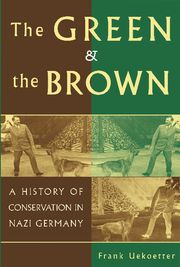Book contents
- Frontmatter
- Contents
- Acknowledgments
- Abbreviations
- A Note on Vocabulary
- 1 The Nazis and the Environment: A Relevant Topic?
- 2 Ideas: Diverse Roots and a Common Cause
- 3 Institutions: Working Toward the Führer
- 4 Conservation at Work: Four Case Studies
- 5 On the Paper Trail: The Everyday Business of Conservation
- 6 Changes in the Land
- 7 Continuity and Silence: Conservation after 1945
- 8 Lessons
- Appendix: Some Remarks on the Literature and Sources
- Selected Bibliography
- Index
7 - Continuity and Silence: Conservation after 1945
Published online by Cambridge University Press: 02 December 2009
- Frontmatter
- Contents
- Acknowledgments
- Abbreviations
- A Note on Vocabulary
- 1 The Nazis and the Environment: A Relevant Topic?
- 2 Ideas: Diverse Roots and a Common Cause
- 3 Institutions: Working Toward the Führer
- 4 Conservation at Work: Four Case Studies
- 5 On the Paper Trail: The Everyday Business of Conservation
- 6 Changes in the Land
- 7 Continuity and Silence: Conservation after 1945
- 8 Lessons
- Appendix: Some Remarks on the Literature and Sources
- Selected Bibliography
- Index
Summary
Uncertainty was the dominant sentiment in the German population in the summer of 1945. Of course, people were glad that they had survived the war, but the exigencies of everyday life made it difficult to rejoice. Six years of war had taken its toll practically everywhere, and living conditions were always difficult and often disastrous. In many cases, city dwellers were hit particularly hard: the war had destroyed more than half of all urban housing, and the remaining population was mostly starving. The food supply was meager at best: in the summer of 1945, the average urbanite received only 1,300 calories a day in Munich, 1,000 in Stuttgart, and 700 to 800 in the Ruhr region. This dismal situation was made worse by a total lack of political power: after the unconditional surrender of the Nazi regime on May 8, 1945, there was no longer a national authority, neither institutionally nor in spirit, that could voice the concerns of the German population. Instead, Allied soldiers stood in all parts of Germany, and everybody knew that these soldiers were under the impression of a kind of warfare that the world had never seen. Therefore, it should come as no surprise that few Germans showed much interest in politics in 1945; whereas the German defeat in World War I had led to a political radicalization, most Germans were now tired of anything that smacked of ideology.
- Type
- Chapter
- Information
- The Green and the BrownA History of Conservation in Nazi Germany, pp. 184 - 201Publisher: Cambridge University PressPrint publication year: 2006

